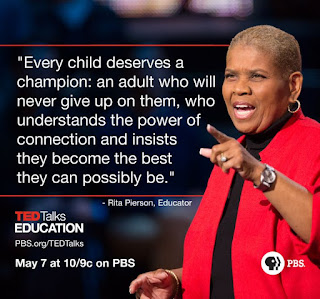Last
week, Fatima Rich asked us to think about our beliefs about good teaching. She made the argument that we are all
learners together, and that professional growth is absolutely essential. This week I offer another “image of the
teacher.”
 |
| This supports Fatima's argument! |
This
entry was organized by Jagga Rent, one of the deans at Hamilton Southeastern High
School. He shares a few stories about
their Reaching Out to Another Royal (ROAR) program, which creates intentional
relationships between students and teachers.
Yale
Professor and educator, James Comer, made the statement illustrated below in the red box.
The
educators at Hamilton Southeastern took this concept seriously and decided to
do more than simply leave relationships to chance. Below are four vignettes about ROAR champions
and students.
Enjoy!
ROAR is
giving teachers a greater opportunity to do what they got into this profession
for...to change lives. This program has the support of our principal, Matt
Kegley, and his support is much of the reason the success rate is so high and
fast. The conversation in our building is changing from being about “those kids”
to being about “our kids.”
ROAR is
making an impact one student at a time.
--Jagga Rent
From Kristen Carwile: Engagement
Brings Success
Brianna
is my ROAR student and was last year, but she was also a student of mine in
English 11. She had struggled all year, as she had in her other classes,
and much of it was due to her sporadic attendance. When we started our
Genius Hour projects, Brianna began a transformation. She started coming to
school every day and really got into making that project her own (which,
coincidentally, is exactly what the project is all about). I think she
finally felt that she was good at something and had a voice to share some of
her struggles, and then she learned that she was not alone in her
struggles. She finished the year passing English 11 and most of her other
classes.
 |
| Kristen and her ROAR Student |
From Aaron Vest: Do Your
Research
My
mentee and I were able to make great progress. He was in my Spanish class last
year, so I had one natural connection. I also had one of his siblings
before and was hoping that I could use those connections as well. After
calling and talking at length with his mom, I found out about many of the
personal challenges he was facing at home and found out about some of his
interests outside of school.
I meet
with him several times and asked him what it was that he needed from me in
order to get his grades up. After talking, we decided on
an assignment notebook that he would come by and show me every day,
in addition to coming to my class a little early each day. We also talked
about our common interests, and this helped.
He has showed
great improvement in all of his classes. He was missing assignments
regularly at the beginning of the year but gave more effort in all
classes to get things turned in.
I continue
to talk to him regularly and am excited about the coming school year.
To see a short movie about last spring's End-of-Year Celebration for ROAR Mentors and Students, Click the link.
About Cliff Bailey: Encourage Connections
Cliff
Bailey, one of our original Royals Intervention Team Advisors, recently shared
a story with us. If you don’t know it, Cliff is the HSE Rugby Team
Sponsor. After having selected his ROAR student, Cliff began talking
about the Rugby team in conversation. One thing led to another, and his
student eventually decided to go out for the team and get involved in
something—for the first time in his life. As a result, the young man was
recognized at Rugby Senior Night, something that would never have happened
without Cliff having built that relationship with his student.
About Angela Fritz: A Small Act
of Kindness
Angela
Fritz took a young man under her wing who was quite reluctant to meet or talk
at first. Over the course of time, she discovered he liked drawing, even
though he was not an art student. This student eventually became comfortable
enough to share his drawings with Angela, but they were on lined school
paper. Realizing he didn’t have a sketchbook at school, Angela gave him
one. Needless to say, he was shocked and delighted. Relationships are built just like this—one
small interaction at a time.
Have a great week, HSE!
Your HSE Teaching and Learning Team
- Jan Combs, Assistant
Superintendent of Teaching and Learning
- Stephanie Loane, Director of
Elementary Education
- Tom Bell, Director of Special
Education
- Jeff Harrison, Director of Educational
Technology
- Phil Lederach, Director of Secondary Education



























